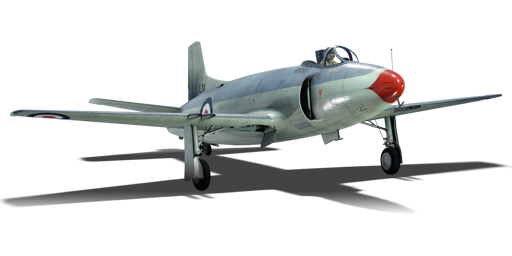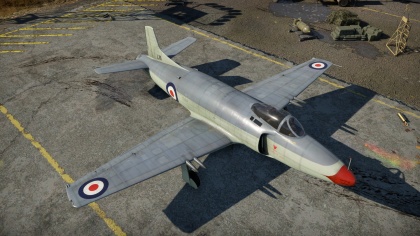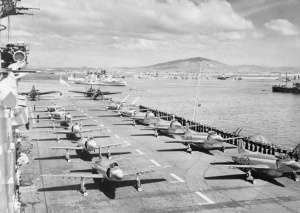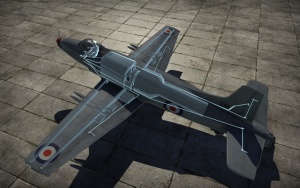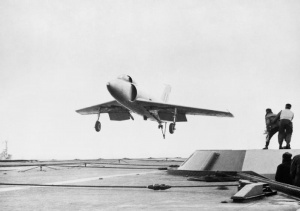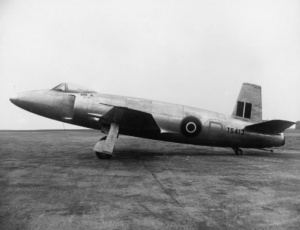Attacker FB 1
Contents
Description
The Attacker FB 1 is a rank V British jet fighter
with a battle rating of 7.3 (AB/SB) and 7.0 (RB). It was introduced in Update 1.49 "Weapons of Victory".
Following the Sea Fury in the Fleet Air Arm branch is the first operational carrier-based jet in the Royal Navy’s arsenal, the Supermarine Attacker. The Attacker was Britain's first naval jet and offers good all-around performance for a first generation jet design, as well as varied ground attack and fighter-bomber capabilities. Available to research after the Sea Fury, the Attacker is a different approach to jet fighter aircraft by comparison to the Meteors, Vampire or Venom.
The most unique and unusual trait of the Attacker is its taildragger configuration and wing-mounted armament. As the wing and undercarriage are shared with another Supermarine aircraft, the Spiteful, the Attacker is the only British jet from its period to feature wing mounted cannon armament. Unlike other British jet fighters that adopt nose mounted configurations, the 4 x 20 mm Hispano Mk V cannons on the Attacker do require careful use of convergence as a result of their positioning, much like the Sea Fury and Seafires.
Mounted in pairs with two in each wing, the Hispano cannons have 624 rounds of ammunition, more than the piston fighters before it. The Attacker can also mount 2 x 500 lb or 2 x 1,000 lb bombs as well as 12 x 76 mm RP-3 rockets with the GLBC Mk 3 and GRC Mk 8 modifications respectively. This combined with the universal or ground targets belts allows the Attacker to live up to its namesake, should pilots choose to use it in a fast ground-attack fighter-bomber role.
The unusual undercarriage is also very forgiving during landings, both on airfields and aircraft carriers. However, this can also prove to be a hindrance in simulator mode and for pilots who prefer cockpit view; the aircraft is indeed a taildragger. This results in an extremely restricted view on the ground and while landing, especially on a carrier.
General info
Flight Performance
| Characteristics | Max Speed (km/h at 0 m - sea level) |
Max altitude (metres) |
Turn time (seconds) |
Rate of climb (metres/second) |
Take-off run (metres) | |||
|---|---|---|---|---|---|---|---|---|
| AB | RB | AB | RB | AB | RB | |||
| Stock | 885 | 859 | 12191 | 26.2 | 26.9 | 22.8 | 21.5 | 950 |
| Upgraded | 936 | 922 | 23.9 | 25.0 | 33.8 | 28.0 | ||
Details
| Features | |||||
|---|---|---|---|---|---|
| Combat flaps | Take-off flaps | Landing flaps | Air brakes | Arrestor gear | Drogue chute |
| ✓ | ✓ | ✓ | ✓ | ✓ | X |
| Limits | ||||||
|---|---|---|---|---|---|---|
| Wings (km/h) | Gear (km/h) | Flaps (km/h) | Max Static G | |||
| Combat | Take-off | Landing | + | - | ||
| 0 | 351 | 520 | 520 | 351 | ~16 | ~9 |
| Optimal velocities (km/h) | |||
|---|---|---|---|
| Ailerons | Rudder | Elevators | Radiator |
| < 491 | < 600 | < 620 | N/A |
Engine performance
| Engine | Aircraft mass | |||||
|---|---|---|---|---|---|---|
| Engine name | Number | Empty mass | Wing loading (full fuel) | |||
| Rolls-Royce Nene-3 | 1 | 4,400 kg | 261 kg/m2 | |||
| Engine characteristics | Mass with fuel (no weapons load) | Max Takeoff Weight | ||||
| Weight (each) | Type | 8m fuel | 20m fuel | 29m fuel | ||
| 930 kg | Centrifugal-flow turbojet | 4,690 kg | 5,120 kg | 5,442 kg | 7,170 kg | |
| Maximum engine thrust @ 0 m (RB / SB) | Thrust to weight ratio @ 0 m (100%) | |||||
| Condition | 100% | WEP | 8m fuel | 20m fuel | 29m fuel | MTOW |
| Stationary | 2,109 kgf | N/A | 0.45 | 0.41 | 0.39 | 0.29 |
| Optimal | 2,109 kgf (0 km/h) |
N/A | 0.45 | 0.41 | 0.39 | 0.29 |
Survivability and armour
- 38 mm Bulletproof glass - Armoured windscreen
- 12.7 mm Steel - Armour plate behind the pilot's seat
Armaments
Offensive armament
The Attacker FB 1 is armed with:
- 4 x 20 mm Hispano Mk.V cannon, wing-mounted (167 rpg inner, 145 outer = 624 total)
Suspended armament
The Attacker FB 1 can be outfitted with the following ordinance:
- 2 x G.P. 500 lb Mk.IV bombs (1,000 lb total)
- 2 x G.P. 1,000 lb Mk.I bombs (2,000 lb total
- 12 x 76 mm RP-3 rockets
Usage in battles
Utilizing the Air Targets belt and adopting a pure fighter role in the Attacker is fairly effective thanks to the aircraft's good all-round performance. Its bubble canopy offers good all-around visibility for simulator pilots, and a set of air brakes situated in the wings aid in slowing the aircraft for energy management purposes.
Modules
| Tier | Flight performance | Survivability | Weaponry | ||
|---|---|---|---|---|---|
| I | Fuselage Repair | Offensive 20 mm | |||
| II | Compressor | Airframe | GLBC mk.3 | ||
| III | Wings Repair | Engine | New 20 mm Cannons | ||
| IV | G-Suit | Cover | GRC mk.8 | ||
Pros and cons
Pros:
- Powerful armament consisting of 4 x 20 mm Hispano Mk V cannons
- Wide track undercarriage for easier, stable landings
- Ability to land on carriers
- Clear visibility cockpit with good all-round vision
- Good ground strike payloads for multi-role capabilities
- Air brakes
- Good rate of climb
Cons:
- Poor acceleration
- Wing-mounted cannons prove to be lacking when compared to the nose-mounted armament of other jets
- The taildragger gear configuration makes for difficult carrier take-off's and landings, particularly in simulator battles
History
The Attacker was part of the first generation of jet aircraft to enter service with the Royal Navy and had the distinction of being the first operational combat jet on a British carrier. Whilst the Royal Air Force was already equipped with Meteors and Vampires, the Fleet Air Arm fell behind due to the difficulty of operating such a radical new technology from the Navy’s existing carriers. This was partially the reasoning the FAA showed interest in the Sea Fury and the later Griffon Seafires as a “make-do” solution.
After trials with the De Havilland Sea Vampire, the Navy wanted a jet aircraft that could be operated from its current ships. Supermarine’s failed Spitfire replacement, the Spiteful, was rejected by both the FAA and RAF due to already sufficient stocks of operational piston engine aircraft. However, this led to a jet engine design incorporating the same wing and undercarriage from the Spiteful, along with a tail wheel configuration as a result, and utilized a Rolls Royce Nene jet engine.
This rather primitive and rushed design was operational from 1951; however it had an extremely short career - being taken out of front-line service by 1954. This was primarily due to the aircraft's limitations being a "tail-dragger" that made operating on anything other than the deck of an aircraft carrier problematic because of the jet exhaust. The rear tail wheel only made the already hazardous task of operating a jet on a carrier even more problematic for pilots.
The Attacker quickly became superseded by the Hawker Sea Hawk and De Havilland Sea Venom, both of which were much more modern and refined designs featuring more powerful engines, tricycle undercarriages, and possessing superior performance. The Attacker did, however, serve as the base of Supermarine’s first swept-wing jet for the RAF, the Swift, as can be seen by the similarity of the nose and fuselage. It would also lead to the more successful Supermarine Scimitar naval jet fighter in the later part of the 1950s.
Whilst the Attacker saw no major service and was relatively short-lived from an operational standpoint, it nonetheless holds the distinction of being the very first of a very new breed of carrier-borne aircraft and the first chapter in a rapidly advancing era of aviation evolution.
In-game description
Whilst the world’s leading air forces forged ahead with the development of new jet aircraft in the mid to late 1940s, naval aviation was left behind in the piston era due to the as of yet undefeated complexities of successfully operating jet aircraft from aircraft carriers. Whilst purpose designed naval jet aircraft were still embryonic in Britain, there was at least still some scope for converting land based jet aircraft.
Supermarine had enjoyed the premium position as the designer and manufacturer of fighter aircraft with the world-beating Spitfire, but were now in danger of being left behind by other British aviation companies who had moved ahead with jet fighters. The Supermarine Attacker was originally developed for the RAF as a land based jet in accordance with Spec E.10/44, with its prototype first flying in July 1946.
Powered by the Rolls-Royce Nene engine and using the laminar flow wing which had been successfully tested on the Spiteful, the Attacker failed to offer any performance advantage over the Meteor or Vampire and so was rejected by the RAF. The Fleet Air Arm, however, saw some potential in the aircraft’s navalised prototypes and pursued the design to carrier trials in October 1947.
The first production Supermarine Attacker flew in May 1950 and 800 Naval Air Squadron became the first front line jet fighter squadron of the Royal Navy in August 1951 – although some jet experience had been gleaned from a small number of de Havilland Vampires purchased for just that reason.
Armed with four 20mm Hispano cannon and able to carry eight 60 lb rockets or two 1000 lb bombs, the Attacker was capable of reaching 590 mph at sea level and climbing at 6350 feet per minute. However, the Attacker was a true first generation jet fighter and was already outclassed by fighters of other nations when it entered service. It served only briefly as a front line fighter, being replaced by the Sea Hawk and Sea Venom from 1954 onwards.
It continued in second line service with the Royal Naval Volunteer Reserve until 1957, and was also used by the Royal Pakistan Air Force.
Media
Excellent additions to the article would be video guides, screenshots from the game, and photos.
See also
- Ar 234 C-3 - A common enemy of the Attacker at the same 7.0 battle rating, the Ar 234 C-3 has comparable ground-attack capabilities.
External links
| Supermarine | |
|---|---|
| Spitfires | |
| Merlin engine | Spitfire Mk Ia · Spitfire Mk IIa · Spitfire Mk.IIa Venture I · Spitfire Mk IIb |
| Spitfire Mk Vb · Spitfire Mk Vb/trop · Spitfire Mk Vc · Spitfire Mk Vc/trop | |
| Spitfire F Mk IX · Spitfire F Mk IXc · Spitfire F Mk XVI | |
| Spitfire LF Mk IX · Plagis' Spitfire LF Mk IXc | |
| Griffon engine | Spitfire F Mk XIVc · Spitfire F Mk XIVe · Prendergast's Spitfire FR Mk XIVe · Spitfire F Mk XVIIIe · Spitfire F Mk 22 · Spitfire F Mk 24 |
| Export | ▄Spitfire Mk Vb/trop · ▃Spitfire LF Mk IXc · ▂Spitfire Mk IXc · Spitfire Mk IXc · Spitfire Mk.IX (CW) · Weizman's Spitfire LF Mk.IXe · ▄Spitfire FR Mk XIVe |
| Seafires | Seafire LF Mk.III · Seafire F Mk XVII · Seafire FR 47 |
| Export | ▄Seafire LF Mk.III |
| Jet fighters | Attacker FB 1 · Attacker FB.2 · Scimitar F Mk.1 · Swift F.1 · Swift F.7 |
| Hydroplanes | Walrus Mk.I |
| Britain jet aircraft | |
|---|---|
| Blackburn | Buccaneer S.1 · Buccaneer S.2 · Buccaneer S.2B |
| British Aerospace | Harrier GR.7 · Sea Harrier FRS.1 (e) · Sea Harrier FRS.1 · Sea Harrier FA 2 |
| British Aircraft Corporation | Strikemaster Mk.88 |
| English Electric | Canberra B Mk 2 · Canberra B (I) Mk 6 · Lightning F.6 · Lightning F.53 |
| Gloster | Meteor F Mk 3 · Sea Meteor F Mk 3 · Meteor F Mk 4 G.41F · Meteor F Mk 4 G.41G · Meteor F Mk 8 G.41K · Meteor F Mk.8 Reaper |
| Javelin F.(A.W.) Mk.9 | |
| de Havilland | Vampire F.B.5 · Venom FB.4 · Sea Venom FAW 20 · Sea Vixen F.A.W. Mk.2 |
| Hawker | Sea Hawk FGA.6 · Hunter F.1 · Hunter F.6 · Hunter FGA.9 · Harrier GR.1 · Harrier GR.3 |
| Panavia | Tornado GR.1 · Tornado GR.4 · Tornado F.3 · Tornado F.3 Late |
| SEPECAT | Jaguar GR.1 · Jaguar GR.1A · Jaguar IS |
| Supermarine | Attacker FB 1 · Attacker FB.2 · Scimitar F Mk.1 · Swift F.1 · Swift F.7 |
| Foreign | Phantom FG.1 (USA) · Phantom FGR.2 (USA) · F-4J(UK) Phantom II (USA) |
| Australia | F-111C |
| India | ▄MiG-21 Bison |
| South Africa | ▄JAS39C |


